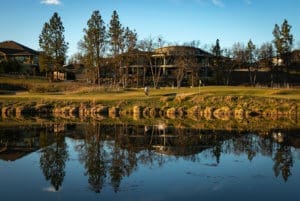As vast swaths of the nation suffer from dramatic changes in climatic conditions, golf courses serve an essential role in water conservation and sustainability. The United States Golf Association (USGA) is a major proponent of environmental sustainability initiatives, including developing courses that minimize their impact on the natural surroundings, limit water consumption for irrigation, and use sound drainage systems.
Golf courses have long been recognized as a way to preserve the natural environment amidst decades of development and urbanization. As neighborhoods and city centers grow, more land is covered by asphalt, concrete, gravel, and structures. Each of those has negative impacts on the water absorption and drainage systems, creating extreme conditions from aridity to flooding. Of course, golf courses provide an enjoyable sport for players, but they also create acres of preserved land for plants and wildlife that players and nonplayers equally enjoy.
Water conservation mutually benefits the environment and the course’s bottom line.
In a 2015 article published by Wharton, Rand Jerris, senior managing director for public services at the USGA, reported the national average a golf course spent on irrigation alone was $600,000 a year. For drought-stricken areas in California, that number topped $2 million. Using less water for irrigation saves cut operational expenses significantly. By implementing robust sustainability initiatives, the land and wildlife thrive, and the business operates more efficiently.
Water conservation is at the heart of golf course architect Robert Trent Jones, Jr.
 The Eagle Point Golf Club was designed in 1996 by world-renowned golf course architect Robert Trent Jones, Jr. Following his father’s footsteps, Jones has designed more than 280 golf courses that combine environmental sustainability with one-of-a-kind strategic challenges at every hole. Throughout his lifetime, Jones has been exposed to the ups and downs of the golfing industry, motivating him to continue the tradition of building picturesque golf courses that support the natural environment. Some of the guiding principles of his organization’s designs include:
The Eagle Point Golf Club was designed in 1996 by world-renowned golf course architect Robert Trent Jones, Jr. Following his father’s footsteps, Jones has designed more than 280 golf courses that combine environmental sustainability with one-of-a-kind strategic challenges at every hole. Throughout his lifetime, Jones has been exposed to the ups and downs of the golfing industry, motivating him to continue the tradition of building picturesque golf courses that support the natural environment. Some of the guiding principles of his organization’s designs include:
- Create challenging, beautiful, and natural layouts with less irrigable turf to help reduce overall water consumption.
- Maximize the efficiency of the water used by employing state-of-the-art technology such as soil moisture sensors and other monitoring equipment, as well as precision pump stations and water distribution systems.
- Modify soil profiles to improve drainage and increase the health of turf grass so it can thrive on less water.
- Choose the most appropriate turf grasses and plantings for specific sites and micro-climates.
- Focus on environmental and financial sustainability on every golf hole on every project.
Read about all of Jones’s guidelines here.
Ready to see what a well-designed golf course is like?
We invite you to visit and play our course at the Eagle Point Golf Club. With six tees at every hole, our game is designed to meet every golfer’s skill level from beginner to professional. Enjoy a cozy stay at The Chalets, where you can awake to the sounds of chirping birds and enjoy a cup of coffee on your private balcony overlooking the greens. You’ll be surrounded by the beauty of Southern Oregon at every turn. Our staff will even work with you to combine your golfing adventure with other local activities for a complete Stay-N-Play experience. We can’t wait to meet you!

Leave a Reply